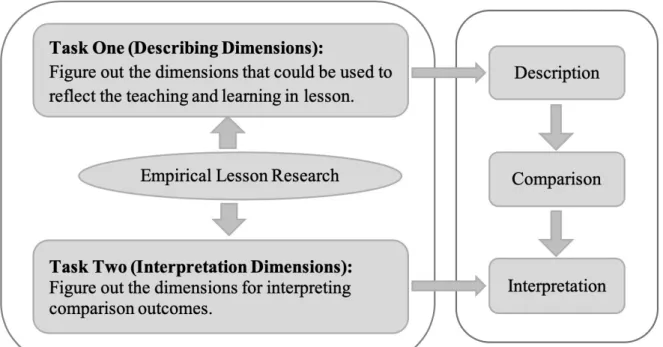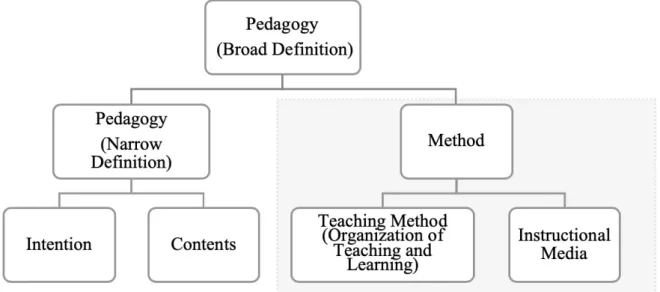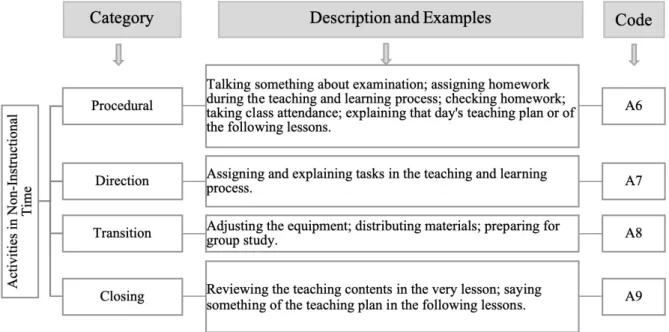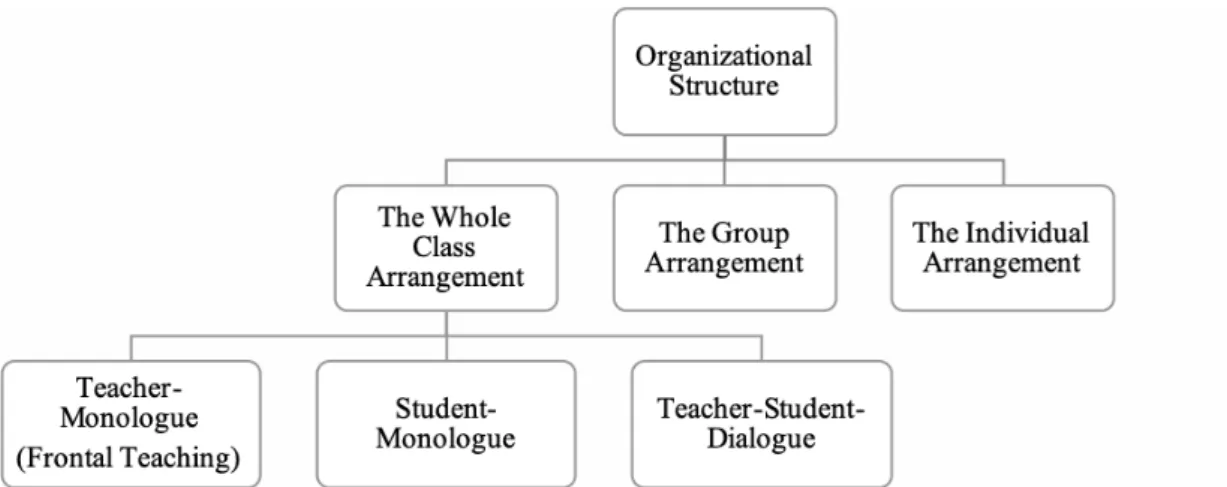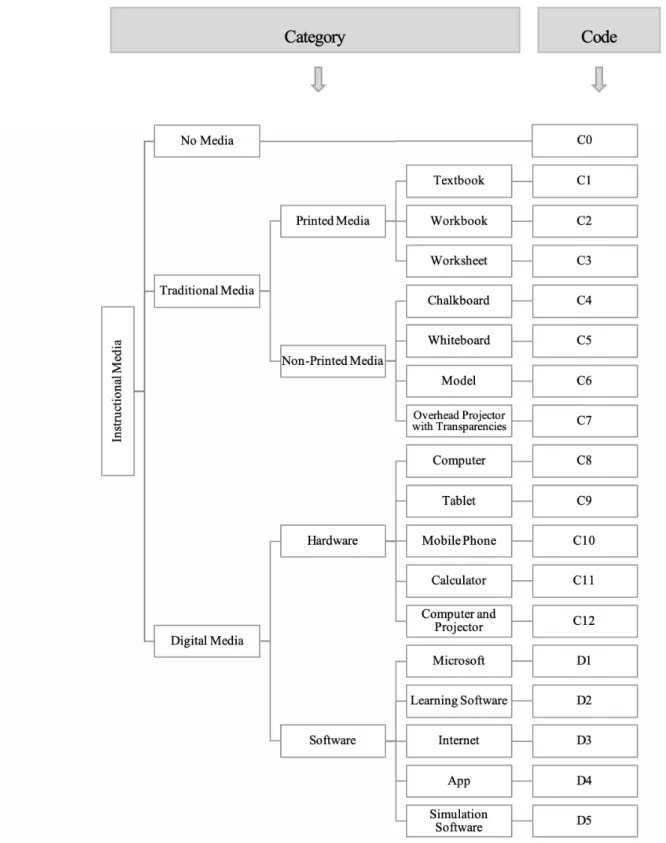Lehr-Lern-Prozess an deutschen und chinesischen berufsbildenden Schulen im Vergleich: Eine koordinierende Unterrichtsbeobachtungsstudie
(Comparison of the Teaching and Learning in German and Chinese VET Schools: A Systematic Classroom Observation Study)
Inauguraldissertation zur
Erlangung des Doktorgrades der
Wirtschafts- und Sozialwissenschaftlichen Fakultät der
Universität zu Köln 2019
vorgelegt von
M.Ed. Henan Guo aus
Ji Lin, China
Vorsitzende der Prüfungskommission: Prof. Dr. Martina Fuchs Referent: Prof. Dr. Matthias Pilz
Korreferent: Prof. Dr. Detlef Buschfeld
Mündliche Prüfung: 28.01.2020
Acknowledgement
For me, pursuing the title of Dr. is a long journey. At the same time, life abroad was also a challenge for me. Thinking over the past six years, a lot of people have helped me on this journey. Here I would like to express my sincere thanks.
Firstly, I am indebted to my supervisor, Prof. Dr. Matthias Pilz. His guidance and overall insights in this field have made this an inspiring experience for me. On the academic level, he taught me how to conduct empirical research in education. On the personal level, he inspired me by his hardworking and passionate attitude.
Besides, I would like to thank those who involved in this research project. It includes my master advisor, Prof. Dr. Zhen He from Beijing Normal University who helped me to make contact with Chinese schools. At the same time, I would like to express my especial thanks to those German and Chinese teachers and students who were under my observation for the purpose of data collection. Without their permission and understanding, this study cannot be completed.
Nobody has been more important to me in the pursuit of this project than the members of my family. Here, I would like to thank my parents, who love and always support me. Most importantly, I would like to thank my loving and supportive husband, as well as my little daughter, who provide unending inspiration.
Meanwhile, I sincerely appreciated all the help from my colleagues and friends: Dr.
Jun-min Li, Mrs. Lea Zenner-Höffkes, Mr. Sebastian Schneider, Dr. Cai-ling Yan, Dr. Ying- yi Zhou. Also, I would like to thank the members of the defense committee: Prof. Dr. Martina Fuchs and Prof. Dr. Detlef Buschfeld.
Last but not the least, I would like to thank the China Scholarship Council, who provided me with financial support and gave me such a wonderful opportunity to further my study abroad.
02.2020 Munich
Table of Contents
CHAPTER ONE: INTRODUCTION ... 1
1.1 THE AIM OF THIS STUDY ... 2
1.2 THE STRUCTURE OF THIS STUDY ... 4
CHAPTER TWO: RESEARCH STATUS ... 7
2.1CROSS-CULTURAL COMPARISON OF TEACHING AND LEARNING IN CLASSROOM ... 7
2.2TEACHING AND LEARNING IN ACCOUNTING IN THE COMPARED COUNTRIES ... 12
2.2.1 Teaching and learning in accounting in German VET schools ... 12
2.2.2 Teaching and learning in accounting in Chinese VET schools ... 16
2.2.3 Conclusion: Comparative data not available ... 17
CHAPTER THREE:THEORETICAL CONSIDERATIONS ... 19
3.1PARADIGMS OF EMPIRICAL LESSON RESEARCH ... 19
3.2UNDERSTANDING OF LESSON (OFFER-USE MODEL) ... 20
3.3DIMENSIONS FOR DESCRIBING TEACHING AND LEARNING ... 23
3.3.1 Teaching and learning as one significant segment group in a lesson ... 23
3.3.2 Reflection of teaching and learning ... 25
3.4DIMENSIONS FOR INTERPRETING THE COMPARISON OUTCOMES ... 27
3.4.1 External contextual factors on the macro level – government ... 30
3.4.2 External contextual factors on the meso level – school ... 32
3.4.3 External contextual factors on the micro level – classroom ... 32
3.4.4 Summary: Four possible interpretation dimensions ... 33
CHAPTER FOUR: RESEARCH METHODOLOGY AND RESEARCH DESIGN ... 35
4.1EMPIRICAL LESSON RESEARCH ... 35
4.1.1 Reasons for selecting observation as the data collection method ... 35
4.1.2 The observation type in this study ... 37
4.2COMPARATIVEVOCATIONAL EDUCATION AND TRAINING (VET)STUDY ... 40
4.2.1 Descriptive and quantified approach behind this comparative study ... 40
4.2.2 The three selections in this study ... 41
4.3RESEARCHDESIGN ... 57
4.3.1 Steps of systematic classroom observation ... 58
4.3.2 Steps of comparative educational research ... 59
4.3.3 Research design of this study ... 61
CHAPTER FIVE:CONSTRUCTION OF THE OBSERVATIONAL INSTRUMENT ... 64
5.1DEVELOPMENT OF THE CATEGORY SYSTEM ... 64
5.1.1 Sub-Category System 1: Activities in non-instructional time ... 66
5.1.2 Sub-Category System 2: Activities in non-engaged time ... 67
5.1.3 Sub-Category System 3: Teaching Method ... 68
5.1.4 Sub-Category System 4: Instructional media ... 79
5.2TIMESAMPLING AS THE RECORDING METHOD ... 84
5.3CONSTRUCTION OF A STANDARDIZED OBSERVATION TABLE ... 86
CHAPTER SIX: CLASSROOM LIFE IN GERMAN SCHOOLS ... 89
6.1DESCRIPTION OF THE OBSERVATION SAMPLES ... 89
6.2ADESCRIPTION OF THE OBSERVATIONAL RESULTS FROM GERMAN SCHOOLS ... 91
6.2.1 Activities in non-instructional time ... 92
6.2.2 Activities in non-engaged time ... 94
6.2.3 Use of teaching methods in German schools ... 97
6.2.4 Use of instructional media in German schools ... 103
6.3INTERIMCONCLUSION ... 108
6.3.1 Characteristics of the adoption of teaching methods and instructional media in German schools ... 108
6.3.2 The validity of the observation results ... 109
CHAPTER SEVEN: CLASSROOM LIFE IN CHINESE SCHOOLS ... 112
7.1DESCRIPTION OF THE OBSERVATION SAMPLES ... 112
7.2DESCRIPTION OF THE OBSERVATIONAL RESULTS FROM CHINESE SCHOOLS ... 115
7.2.1 Activities in non-instructional time ... 116
7.2.2 Activities in non-engaged time ... 119
7.2.3 Use of teaching methods in Chinese schools ... 122
7.2.4 Use of instructional media in Chinese schools ... 128
7.3INTERIMCONCLUSION ... 132
7.3.1 Characteristics of the adoption of teaching methods and instructional media in Chinese schools ... 133
7.3.2 The validity of the observation results ... 134
CHAPTER EIGHT: CROSS-CULTURAL COMPARISON AND INTERPRETATION OF THE COMPARISON RESULT 135 8.1COMPARISON OF THE CONTEXTUAL FACTORS ... 135
8.1.1 External – macro level – government – teacher education ... 136
8.1.2 External – macro level – government – curriculum ... 145
8.1.3 External – Meso Level – School – Media Availability. ... 152
8.1.4 External – micro level – class size. ... 155
8.1.5 Summary: Three determinants for interpreting the comparison outcomes. ... 155
8.2ELABORATION OF THE COMPARISON OUTCOMES ... 156
8.2.1 Comparing the use of teaching methods in German and Chinese schools. ... 157
8.2.2 Comparing the use of instructional media in German and Chinese schools. ... 165
8.2.3 Summary: Ten comparison outcomes within seven observation indicators. ... 170
8.3RELATING THE COMPARISON OUTCOMES TO THE CONTEXTUAL DIFFERENCES ... 173
8.3.1 The influence of different teacher education. ... 173
8.3.2 The influence of different curriculum. ... 175
8.3.3 The influence of different media availability. ... 178
8.3.4 Those unaccounted relationships. ... 179
CHAPTER NINE: CONCLUSION, IMPLICATIONS FOR PRACTICE AND POLICY, LIMITATIONS AND PERSPECTIVES ... 182
9.1CONCLUSIONS ... 182
9.1.1 From a comparative view: Teacher-dominant in Chinese schools and students-dominant in German schools. ... 182
9.1.2 No essential difference of the digital media utilization. ... 183
9.1.3 Teacher education and curriculum are the key points for explaining the different teaching and learning in German and Chinese schools. ... 184
9.2IMPLICATIONS AND RECOMMENDATIONS FOR POLICY-BORROWING ... 184
9.2.1 Pedagogical knowledge should be given more emphasis in Chinese VET teacher education. ... 184
9.2.2 From examination-oriented to competence-oriented: The curriculum for major accounting in Chinese VET schools. ... 186
9.3CONTRIBUTIONS,LIMITATIONS OF THIS RESEARCH AND IMPLICATIONS FOR FUTURE STUDY ... 187
REFERENCES ... 189
THE AUTHOR’S CV...………213
List of Tables
TABLE 2.1OVERVIEW OF THE RELEVANT COMPARATIVE STUDIES ... 10
TABLE 2.2OVERVIEW OF THE RELEVANT GERMAN STUDIES ... 15
TABLE 2.3COMPARISON OF THE DATA AVAILABILITY IN GERMANY AND CHINA ... 18
TABLE 4.1OBSERVATION TYPES ... 40
TABLE 4.2CURRICULUM STRUCTURE OF THE SAMPLE MAJOR IN GERMAN VETSCHOOLS ... 52
TABLE 4.3LEARNING ARENAS IN THE TARGET COURSE ... 53
TABLE 4.4PROFESSIONAL COURSES IN CHINESE SCHOOLS ... 56
TABLE 4.5ASERIES OF SELECTIONS IN THIS COMPARATIVE STUDY ... 57
TABLE 5.1DESCRIPTION OF THREE ORGANIZATIONAL STRUCTURES ... 71
TABLE 5.2STANDARDIZED OBSERVATION TABLE ... 87
TABLE 6.1DESCRIPTION OF STUDENTS AND CLASSROOMS IN GERMAN SAMPLE SCHOOLS ... 90
TABLE 6.2DESCRIPTION OF GERMAN SAMPLE TEACHERS ... 91
TABLE 6.3TIME ALLOCATION IN GERMAN SCHOOLS (MINUTES [MIN.]/TEACHING HOUR) ... 91
TABLE 6.4TEACHING AND LEARNING NON-RELATED ACTIVITIES IN GERMAN SCHOOLS (MINUTES [MIN.]/TEACHING HOUR) ... 93
TABLE 6.5THE OUTSIDE INTERRUPTION IN GERMAN SCHOOLS ... 94
TABLE 6.6THE DISCIPLINE MANAGEMENT IN GERMAN SCHOOLS ... 94
TABLE 6.7TEACHING AND LEARNING SUPPORTIVE ACTIVITIES IN GERMAN SCHOOLS (MINUTES [MIN.]/TEACHING HOUR) ... 95
TABLE 6.8PROCEDURAL ACTIVITIES IN GERMAN SCHOOLS ... 96
TABLE 6.9TRANSITION ACTIVITIES IN GERMAN SCHOOLS ... 97
TABLE 6.10CLOSING ACTIVITIES IN GERMAN SCHOOLS ... 97
TABLE 6.11ORGANIZATIONAL STRUCTURES IN GERMAN SCHOOLS (MINUTES [MIN.]/TEACHING HOUR) ... 98
TABLE 6.12TEACHER-MONOLOGUE IN GERMAN SCHOOLS (MINUTES [MIN.]/TEACHING HOUR) ... 109
TABLE 6.13STUDENT-MONOLOGUE IN GERMAN SCHOOLS (MINUTES [MIN.]/TEACHING HOUR) ... 100
TABLE 6.14REPORT BY STUDENT IN GERMAN SCHOOLS ... 100
TABLE 6.15TEACHER-STUDENT DIALOGUE IN GERMAN SCHOOLS (MINUTES [MIN.]/TEACHING HOUR) ... 101
TABLE 6.16GROUP ARRANGEMENT IN GERMAN SCHOOLS (MINUTES [MIN.]/TEACHING HOUR) ... 102
TABLE 6.17INDIVIDUAL LEARNING IN GERMAN SCHOOLS ... 103
TABLE 6.18INSTRUCTIONAL MEDIA IN GERMAN SCHOOLS (MINUTES [MIN.]/TEACHING HOUR) ... 104
TABLE 7.1DESCRIPTION OF STUDENTS AND CLASSES IN CHINESE SAMPLE SCHOOLS ... 114
TABLE 7.2DESCRIPTION OF TEACHERS IN CHINESE SAMPLE SCHOOLS ... 115
TABLE 7.3TIME ALLOCATION IN CHINESE SCHOOLS (MINUTES [MIN.]/TEACHING HOUR) ... 116
TABLE 7.4TEACHING AND LEARNING NON-RELATED ACTIVITIES IN CHINESE SCHOOLS (MINUTES [MIN.]/TEACHING HOUR) .... 117
TABLE 7.5OUTSIDE INTERRUPTION IN CHINESE SCHOOLS ... 118
TABLE 7.6DISCIPLINE MANAGEMENT IN CHINESE SCHOOLS ... 119
TABLE 7.7EQUIPMENT PROBLEM IN CHINESE SCHOOLS ... 119
TABLE 7.8TEACHING AND LEARNING SUPPORTIVE ACTIVITIES IN CHINESE SCHOOLS (MINUTES [MIN.]/TEACHING HOUR) ... 120
TABLE 7.9PROCEDURAL ACTIVITIES IN CHINESE SCHOOLS ... 121
TABLE 7.10TRANSITION ACTIVITIES IN CHINESE SCHOOLS ... 121
TABLE 7.11CLOSING ACTIVITIES IN CHINESE SCHOOLS ... 122
TABLE 7.12ORGANIZATIONAL STRUCTURES IN CHINESE SCHOOLS (MINUTES [MIN.]/TEACHING HOUR) ... 123
TABLE 7.13TEACHER-MONOLOGUE IN CHINESE SCHOOLS (MINUTES [MIN.]/TEACHING HOUR) ... 124
TABLE 7.14STUDENT-MONOLOGUE IN CHINESE SCHOOLS (MINUTES [MIN.]/TEACHING HOUR) ... 124
TABLE 7.15TEACHER-STUDENT DIALOGUE IN CHINESE SCHOOLS (MINUTES [MIN.]/TEACHING HOUR) ... 125
TABLE 7.16GROUP ARRANGEMENT IN CHINESE SCHOOLS (MINUTES [MIN.]/TEACHING HOUR) ... 126
TABLE 7.17INDIVIDUAL LEARNING IN CHINESE SCHOOLS (MINUTES [MIN.]/TEACHING HOUR) ... 128
TABLE 7.18INSTRUCTIONAL MEDIA IN CHINESE SCHOOLS (MINUTES [MIN.]/TEACHING HOUR) ... 129
TABLE 8.1COMPETENCE DOMAIN 1–TEACHING IN THE STANDARD FOR TEACHER EDUCATION ... 141
TABLE 8.2THE STANDARD FOR TEACHER PROFESSION IN SECONDARY VOCATIONAL SCHOOLS ... 144
TABLE 8.3THE STRUCTURE OF A LEARNING SITUATION IN THE CURRICULUM ... 149
TABLE 8.4COMPARISON OUTCOMES –TEACHING METHODS ... 159
TABLE 8.5COMPARISON OUTCOMES –TRADITIONAL INSTRUCTIONAL MEDIA ... 168
TABLE 8.6COMPARISON OUTCOMES –MODERN INSTRUCTIONAL MEDIA ... 169
List of Figures
FIGURE 1.1.THE AIM OF THIS STUDY. ... 4
FIGURE 1.2.THE STRUCTURE OF THIS STUDY ... 6
FIGURE 2.1.THE APPROACH FOR LOCALIZING THE DETERMINANTS. ... 12
FIGURE 3.1.A SIMPLIFIED OFFER-USE MODEL. ... 21
FIGURE 3.2.TWO THEORETICAL CONSIDERATIONS INVOLVED INTO THIS STUDY. ... 23
FIGURE 3.3.TEACHING AND LEARNING IN A LESSON. ... 25
FIGURE 3.4.TEACHING METHODS AND INSTRUCTIONAL MEDIA:TWO DIMENSIONS FOR REFLECTION. ... 27
FIGURE 3.5.CONCEPTUAL MODEL FOR INTERPRETATION. ... 29
FIGURE 3.6.FOUR POSSIBLE INTERPRETATION DIMENSIONS. ... 34
FIGURE 4.1.UPPER-SECONDARY VET TYPES IN GERMANY. ... 45
FIGURE 4.2. UPPER-SECONDARY VET IN CHINA. ... 47
FIGURE 4.3.STUDENT NUMBERS IN DIFFERENT GERMAN IVET PROGRAMS. ... 50
FIGURE 4.4.CURRICULUM OF THE MAJOR ACCOUNTING IN 2000. ... 55
FIGURE 4.5.CURRICULUM OF THE MAJOR ACCOUNTING IN 2013. ... 55
FIGURE 4.6.STEPS OF CONDUCTING A STRUCTURED OBSERVATION. ... 59
FIGURE 4.7.COMPARISON STEPS IN THIS STUDY. ... 61
FIGURE 4.8.RESEARCH DESIGN OF THIS STUDY. ... 63
FIGURE 5.1.STRUCTURE OF THE CATEGORY SYSTEM TO BE DEVELOPED. ... 65
FIGURE 5.2.PROCEDURE OF DEVELOPING THE CATEGORY SYSTEM IN THIS STUDY. ... 66
FIGURE 5.3.SUB-CATEGORY SYSTEM 1:ACTIVITIES IN NON-INSTRUCTIONAL TIME. ... 67
FIGURE 5.4.SUB-CATEGORY SYSTEM 2:ACTIVITIES IN NON-ENGAGED TIME. ... 68
FIGURE 5.5.TEACHING AND LEARNING IN ENGAGED TIME. ... 69
FIGURE 5.6.ORGANIZATIONAL STRUCTURE IN THE TEACHING AND LEARNING PROCESS. ... 72
FIGURE 5.7.CATEGORY SYSTEM OF THE WHOLE CLASS ARRANGEMENT. ... 75
FIGURE 5.8. CATEGORIES OF THE GROUP ARRANGEMENT AND THE INDIVIDUAL ARRANGEMENT. ... 78
FIGURE 5.9.SUB-CATEGORY 4:INSTRUCTIONAL MEDIA. ... 83
FIGURE 6.1.TIME ALLOCATION IN GERMAN SCHOOLS (PERCENTAGE [%] OF THE ALLOCATED LESSON TIME). ... 92
FIGURE 6.2.TEACHING AND LEARNING NON-RELATED ACTIVITIES IN GERMAN SCHOOLS (PERCENTAGE [%] OF NON-INSTRUCTIONAL TIME). ... 93
FIGURE 6.3.TEACHING AND LEARNING SUPPORTIVE ACTIVITIES IN GERMAN SCHOOLS (PERCENTAGE [%] OF NON-ENGAGED TIME). 95 FIGURE 6.4.ORGANIZATIONAL STRUCTURES IN GERMAN SCHOOLS (PERCENTAGE [%] OF ENGAGED TIME). ... 98
FIGURE 6.5.THE WHOLE CLASSROOM ARRANGEMENT IN GERMAN SCHOOLS (MINUTES [MIN.]/TEACHING HOUR). ... 99
FIGURE 6.6.STUDENT’S REPORT IN GERMAN SCHOOLS. ... 101
FIGURE 6.7.GROUP WORK IN GERMAN SCHOOLS. ... 103
FIGURE 6.8.INSTRUCTIONAL MEDIA IN GERMAN SCHOOLS (PERCENTAGE [%] OF THE ENGAGED TIME). ... 104
FIGURE 6.9.TRADITIONAL MEDIA IN GERMAN SCHOOLS (MINUTES [MIN.]/TEACHING HOUR). ... 105
FIGURE 6.10.THE USE OF COMPUTERS IN GERMAN SCHOOLS (MINUTES [MIN.]/TEACHING HOUR). ... 107
FIGURE 6.11.THE USE OF AN IPAD IN GERMAN SCHOOLS (MINUTES [MIN.]/TEACHING HOUR). ... 108
FIGURE 6.12.TEACHING METHODS IN GERMAN SCHOOLS (MINUTES [MIN.]/TEACHING HOUR). ... 109
FIGURE 7.1.TRAINING ROOM 1 AND 2 IN CHINESE SCHOOLS. ... 113
FIGURE 7.2.TIME ALLOCATION IN CHINESE SCHOOLS (PERCENTAGE [%] OF THE ALLOCATED LESSON TIME). ... 116
FIGURE 7.3. TEACHING AND LEARNING NON-RELATED ACTIVITIES IN CHINESE SCHOOLS (PERCENTAGE [%] OF THE NON-INSTRUCTIONAL TIME). ... 117
FIGURE 7.4. TEACHING-AND-LEARNING SUPPURATIVE ACTIVITIES IN CHINESE SCHOOLS (PERCENTAGE [%] OF NON-ENGAGED TIME). ... 120
FIGURE 7.5.ORGANIZATIONAL STRUCTURES IN CHINESE SCHOOLS (PERCENTAGE [%] OF THE ENGAGED TIME). ... 122
FIGURE 7.6.THE WHOLE CLASS ARRANGEMENT IN CHINESE SCHOOLS (MINUTES [MIN.]/TEACHING HOUR). ... 123
FIGURE 7.7.INDIVIDUAL LEARNING 1 IN CHINESE SCHOOLS. ... 126
FIGURE 7.8.GROUP WORK IN CHINESE SCHOOLS. ... 127
FIGURE 7.9.INSTRUCTIONAL MEDIA IN CHINESE SCHOOLS (PERCENTAGE [%] OF THE ENGAGED TIME). ... 128
FIGURE 7.10.TRADITIONAL MEDIA IN CHINESE SCHOOLS (MINUTES [MIN.]/TEACHING HOUR). ... 130
FIGURE 7.11.THE USE OF COMPUTERS IN CHINESE SCHOOLS (MINUTES [MIN.]/TEACHING HOUR). ... 131
FIGURE 7.12.THE USE OF MOBILE PHONES IN CHINESE SCHOOLS (MINUTES [MIN.]/TEACHING HOUR). ... 132
FIGURE 7.13.TEACHING METHODS IN CHINESE SCHOOLS (MINUTES [MIN.]/TEACHING HOUR). ... 133
FIGURE 8.1.THE STRUCTURE OF CHAPTER EIGHT. ... 135
FIGURE 8.2.REPRESENTATION OF FIGURE 3.6:FOUR POSSIBLE INTERPRETATION DIMENSIONS. ... 137
FIGURE 8.3.WHICH OF THE FOLLOWING ELECTRONIC MEDIA AND DEVICES ARE AVAILABLE AT YOUR SCHOOL FOR USE IN THE CLASSROOM? ... 153
FIGURE 8.4.THREE DETERMINANTS FOR INTERPRETATION. ... 156
FIGURE 8.5.COMPARISON OF TIME USAGE (PERCENTAGE [%] OF THE ALLOCATED LESSON TIME). ... 157
FIGURE 8.6.COMPARISON OF THE TIME FOR THE CONCRETE TEACHING METHODS (MINUTES [MIN.]/TEACHING HOUR) ... 158
FIGURE 8.7.COMPARISON OF QUESTION AND ANSWER WITH DIFFERENT SEGMENT PURPOSES (MINUTES [MIN.]/TEACHING HOUR). ... 160
FIGURE 8.8.COMPARISON OF QUESTION AND ANSWER FOR DIFFERENT PURPOSES (PERCENTAGE [%] OF THE TOTAL TIME FOR QUESTION AND ANSWER). ... 160
FIGURE 8.9.COMPARISON OF THE USAGE OF QUESTION AND ANSWER (PERCENTAGE [%] OF THE TOTAL TIME FOR QUESTION AND ANSWER). ... 162
FIGURE 8.10.COMPARISON OF THE USE OF GROUP STUDY AND PARTNER STUDY (PERCENTAGE [%] OF THE TOTAL TIME FOR THESE TWO METHODS TOGETHER). ... 163
FIGURE 8.11.COMPARISON OF THE TIME PERCENTAGE FOR INDIVIDUAL LEARNING WITH DIFFERENT ORGANIZATIONAL STRUCTURES (PERCENTAGE [%] OF THE TOTAL TIME FOR INDIVIDUAL LEARNING). ... 164
FIGURE 8.12.COMPARISON OF THE TIME PERCENTAGES OF INDIVIDUAL LEARNING USED FOR DIFFERENT PURPOSES (PERCENTAGE [%] OF THE TIME FOR INDIVIDUAL LEARNING). ... 165
FIGURE 8.13.COMPARISON OF THE USE OF INSTRUCTIONAL MEDIA (PERCENTAGE [%] OF THE ENGAGED TIME). ... 166
FIGURE 8.14.COMPARISON OF THE USE OF INSTRUCTIONAL MEDIA (MINUTES [MIN.]/TEACHING HOUR). ... 166
FIGURE 8.15COMPARISON OF THE USE OF TRADITIONAL MEDIA (MINUTES [MIN.]/TEACHING HOUR) ... 167
FIGURE 8.16COMPARISON OF THE USE OF MODERN MEDIA (MINUTES [MIN.]/TEACHING HOUR) ... 170
FIGURE 8.17.COMPARISON OF THE UTILIZATION OF SOFTWARE (MINUTES[MIN.]/TEACHING HOUR). ... 170
FIGURE 8.18.OVERVIEW OF THE COMPARISON OUTCOMES. ... 172
FIGURE 8.19DIFFERENT TEACHER EDUCATION SYSTEM AND THEIR POSSIBLE INFLUENCE ... 175
FIGURE 8.20DIFFERENT CURRICULUM AND THEIR POSSIBLE INFLUENCE. ... 178
FIGURE 8.21.DIFFERENT MEDIA AVAILABILITY AND THEIR POSSIBLE INFLUENCE. ... 179
FIGURE 8.22.OVERVIEW OF THE RELATIONSHIP BETWEEN THE CONTEXTUAL DIFFERENCES (DETERMINANTS) AND COMPARISON OUTCOMES. ... 181
List of Abbreviations
Cedefop European Centre for the Development of Vocational Training DGfE Die Deutsche Gesellschaft für Erziehungswissenschaft
IVET Initial Vocational Education and Training
IEA International Association for the Evaluation of Educational Achievement
ISCED International Standard Classification of Education KMK die Kultursministerkonferenz (Standing Conference of
Ministers of Education and Cultural Affairs, Germany)
MoE Ministry of Education (China)
NRW Nordrhein-Westfalen (North Rhine-Westphalia, a state in Germany)
OECD Organization for Economic Co-operation and Development PISA Programme for International Student Assessment
TALIS-Video Teaching and Learning International Survey – Video Study TIMMS Trends in International Mathematics and Science Study UNESCO United Nations Educational, Scientific and Cultural
Organization
VET Vocational Education and Training
Chapter One: Introduction
Comparative pedagogy is a crossing research domain which involves two fields:
comparative education and pedagogy study (Alexander, 2001). Its significance was not realized until the beginning of the 21st century and appears in discussions within some comparativists’ studies (e.g., Alexander, 2001; Broadfoot, 2000; Little, 2000).
Since the end of the 20th century, various international assessment-based comparative studies have been carried out. Trends in International Mathematics and Science Study (TIMSS) and The Programme for International Student Assessment (PISA) are seen as the most important and influential research projects worldwide. In these studies, compelling and meaningful findings were derived. However, an explanation to why the students’
achievements were various from countries has not been given. Then some scholars attempted to find answers by taking a glimpse of classroom pedagogic practice, due to its characteristic of being more salient and easier to reform (Elliott, Stankov, Lee, & Beckmann, 2019).
A series of insights that might be gained from a comparative pedagogy study were listed out in an introduction document of the newly-developed international research project – The Teaching and Learning International Survey (TALIS; OECD, 2017). For example, it is beneficial for better understanding the relationship between pedagogical practice and student outcomes as well as for understanding the validity and policy relevance of findings from international surveys.
Another advantage that is particularly significant in this kind of studies is to deepen the understanding of the contextual differences between the compared countries (Aldridge, Fraser, & Huang, 1999; OECD, 2017). In the field of comparative education, contextual factors such as teacher education and curriculum that might definite affect teaching and learning are often regarded as the compared subjects. In most cases, one purpose of these studies is to glean hints for improving teaching quality, as the situation between the compared countries (i.e., Germany and China) in this study.
The German VET is famous world-wide and is regarded as a good practice that should be learned by others, including China. As a result, a majority of Chinese scholars have intended to compare those contextual subjects (e.g., Gao, 2014; Tang, 2016; Xu, 2017).
However, to what extent these contextual differences is reflected in the classroom is unknown. If the teaching and learning in the compared countries are different, how might these differences be attributed to those contextual differences? If they are the same, then is it still meaningful to drawing lessons from other countries? Therefore, from the perspective of policy-borrowing, comparing pedagogical practice is a meaningful approach to understand the degree of implementation of often-praised teaching approaches and then find the proper approach to borrow lessons (OECD, 2017).
At the moment, most of the comparison studies in this field are confined to the
discipline of mathematics and science in general education (see Chapter Two). In the field of Vocational Educational Training (VET), the amount is still insufficient (Pilz, 2016).
Furthermore, a gap can be also seen among comparison studies where Germany and China are the two compared countries.
With such a background, this preliminary study was carried out in the aim to contribute to the field of comparative study of teaching and learning in VET and to strengthen the mutual understanding between Germany and China in the area of VET.
1.1 The Aim of This Study
The fundamental aim of this study is to compare teaching and learning in German and Chinese VET schools. In Chapter Five, it is elaborated that the adoption of teaching methods and media are the proper dimensions for reflecting teaching and learning. This purpose might be, therefore, rephrased as comparing the utilization of teaching methods and instructional media in the classroom (Third Aim in Figure 1.1).
In addition, three other aims are subordinate to this main one. As described in Chapter Two, in the individual countries there is indeed literature in which teaching and
learning in commercial VET schools was described. However, these data are incomparable in that the studies concerning this topic from China are comparatively poor quality and the studies from Germany have the drawback of being region-confined. As such, collecting suitable data is the key point of this study.
Quantitative classroom observation is regarded as the proper method for data collection (see Chapter Five). An observation instrument was needed as the prerequisite to conduct such an observation as one that fulfilled the requirements of this study is currently not available. Therefore, a new instrument that had the possibility of future adoption was developed. This is seen as the first subordinate aim of this study (First Aim in Figure 1.1).
As mentioned previously, teaching and learning both in German and Chinese VET schools is seldom presented to the rest of world, and thus describing teaching and learning in these two countries respectively is the second subordinated aim of this study (Second Aim in Figure 1.1).
Lastly, a final aim of this study is to relate the comparison outcomes derived from observation to the contextual differences between Germany and China (Fourth Aim in Figure 1.1). In fact, the ultimate objective behind this step is to determine the proper approach for policy-borrowing between Germany and China.
Figure 1.1. The aim of this study.
1.2 The Structure of this Study
The overall structure of this study takes the form of nine chapters, including this introductory chapter (see Figure 1.2 below). In Chapter Two, the relevant studies are presented in order to stress the research gap and the necessity for collecting data in both of the compared countries. In Chapter Three, issues concerning the theories underpinning this study are addressed, and it also outlines how to define the compared subject and how to reflect upon it, as well as how to explain it. The fourth chapter is concerned with the
methodology used for this study. In the same chapter, it is concluded that observation is the suitable data collection method in this study. In Chapter Five, a new observational
instrument is developed, which is the first aim elaborated upon in the previous section. In Chapter Six and Chapter Seven, the observation results derived from German and Chinese schools are presented (i.e., the second aim). In Chapter Eight, a comparison is firstly made between some contextual factors. The purpose is to select those factors which show differences between the compared countries. Additionally, a comparison is made on the adoption of teaching methods and instructional media – two dimensions for reflection of
teaching and learning in a lesson (i.e., the third aim). Lastly, the relationship between the contextual differences and different teaching and learning styles is addressed (i.e., the fourth aim). The final chapter, Chapter Nine, draws upon the entire thesis, and advice regarding policy-borrowing between Germany and China is provided on the basis of the findings produced from this study. In this same final chapter, theoretical and empirical strands are presented and the implications of the findings to the future research into this area are discussed.
Figure 1.2. The structure of this study.
Chapter Six:
Teaching and Learning in German Schools (Second Aim) Observational Data
Presentation
Description in the Relevant Studies
Comparison
(First Aim)
Chapter Seven:
Teaching and Learning in Chinese Schools (Second Aim) Observational Data
Presentation Description in the Relevant Studies
Comparison
(First Aim)
Chapter Eight:
Comparison and Interpretation Comparing the Adoption of Teaching
Methods and Instructional Media (Third Aim)
Interpreting Comparing Outcomes by Analyzing Contextual Differences
(Fourth Aim) Chapter One: Introduction
Chapter Two: Research Status
Chapter Three: Theoretical Consideration
Chapter Four: Methodology and Research Design
Chapter Five: Development of the Observation Instrument
(First Aim)
Chapter Nine: Conclusion, Implication, Limitation and Prospect
Chapter Two: Research Status
This chapter is comprised of two sections. In Section 2.1, previous studies comparing the teaching and learning between different cultures, either in general education or vocational education training (VET), are briefly introduced. One purpose for doing so was to stress the gap in existing research in the field of VET. The other purpose was to determine which aspects have been used for reflecting teaching and learning, as well as which dimensions have been adopted for interpreting the comparison outcomes. In Section 2.2, the studies that describe the teaching and learning in German and Chinese VET schools are presented respectively. In this step, the basic situation of classroom life in the two compared countries is initially described. In addition, the researcher sought to determine whether the
comparative data of interest was available, and whether it was necessary to collect data in both of the compared countries.
2.1 Cross-Cultural Comparison of Teaching and Learning in Classroom There is a scant history of comparing classroom life or a lesson’s process data collected from an objective perspective (Pauli & Reusser, 2006). Two trends in the International Mathematics and Science Study (TIMSS) video studies can be seen as the starting point in this field. The TIMSS study was an international education evaluation research project initiated by The International Association for the Evaluation of Educational Achievement (IEA). It was a large-scale assessment project that compared students’
achievement between different countries. The TIMSS video study was one subsequent project which explained the assessment results. As stated by Zhang (2008), the focus of these video studies was shifted from comparing the results of teaching and learning to the process data in classroom. At the moment, only two large-scale video studies have been completed.
The first TIMSS video study was carried out in 1995, in which 231 mathematics lessons from Germany, Japan, and the United States were videotaped (Stigler et al., 1999). In this study, three aspects – mathematical contents, organization of instruction, as well as the
process of instruction – in the teaching and learning process were coded and then compared.
In the end, numerous differences were identified. However, with respect to the possible reasons for these differences, further examination was not conducted.
Following the same project framework, another similar study was conducted in 1999 but in the discipline of science (Roth et al., 2006). This study compared 638 lessons from five countries which were videotaped: Australia, Czech Republic, Japan, the Netherlands, and the United States. In the coding steps, three aspects – science contents, teacher’s actions, and students’ actions – were coded and compared. As in the former study, an interpretation was not attached to the comparison outcomes.
Recently, another project which is the Teaching and Learning International Survey (TALIS) Video Study was issued (OECD, 2017, 2018). In this project, teaching and learning from up to nine countries or economies are going to be compared. As a new project, the aspects used for reflecting the teaching and learning and the aspects for interpretation are still unknown. Nevertheless, from this project it might be acknowledged that keeping a watchful eye on the classroom is the trend. At the same time, the importance of making a cross- cultural comparison of pedagogical practice in the classroom might be further stressed.
Considering this background, similar studies have been conducted but on a
comparatively smaller scale (Table 2.1). Having a glimpse of them, it might be found that all of them focused on the comparison in the discipline of mathematics, science and biology in general education. Then from a broad sense, the research gap, which is the comparison of teaching and learning in VET, exists. In addition, though in the field of general education, the two compared countries in this study were seldom compared in previous literature. The only study uncovered was from Liu and Neuhaus (2017). Thus, a comparison of teaching and learning is also insufficient in studies between Germany and China.
As the research gap has been revealed, subsequent attention should then be shifted to the dimensions for reflecting teaching and learning as well as the dimensions for
interpretation. Essentially, a lesson has both visible and invisible structure. Kunter and Trautwein (2013) described the visible structure (German: Sichtstrukturen) as the organizational structure, the teaching model, and social form of lessons, all of which are observable in the classroom. Certain aspects such as cognitive activation, which are not directly observable, belong to the invisible structure (German: Tiefenstrukturen) of a lesson.
In all of the existing studies, the lessons’ visible structure was compared (Table 2.1). Such an approach is also applicable to this current study.
It has been widely accepted that the invisible structure has a closer relationship with teaching effectiveness (Hattie, 2009; Helmke, 2012; Klieme, 2006; Seidel & Shavelson, 2007). However, the fundamental purpose of this study is to present the actual classroom life and then interpret the comparison outcomes from the contextual differences, instead of making an evaluation or a judgement regarding which country has more efficient lessons.
Such a purpose could be perfectly achieved by describing the visible structure of a lesson, because a visible structure is observable in a short time by an outsider and low-inference data can be collected (Kunter & Trautwein, 2013). Then as in other cross-cultural comparative studies, this study also focuses on the lesson’s visible structure. The adoption of teaching methods and instructional media were used as the concrete reflect dimensions as elaborated in Chapter Three.
Regarding the dimensions for interpreting the differences, culture is usually used as the sole or main consideration for interpretation (Cai & Lester, 2007; Liu & Neuhaus, 2017;
Tao, Oliver, & Venville, 2013). Besides, other factors were mentioned in some individual studies. For example, five factors – curriculum, pressures experienced by teachers, respect for teacher, questioning techniques, and educational aims – were identified from teachers’
interviews in a study by Aldridge et al. (1999). In another study, students’ socioeconomic status was embedded in the research design and the results indicated that this would definitely affect the organization of instruction (Tao et al., 2013).
Table 2.1
Overview of Relevant Comparative Studies
Author (year) Discipline Compared Countries
Dimensions for Reflecting the Teaching and Learning Process.
Dimensions for Interpretation
Stigler et al.
(1999) Mathematics Germany, Japan, the United States
Mathematical content;
organization of instruction;
process of instruction.
-
Aldridge et al.
(1999) Science Taiwan, Australia -
Nature of curriculum;
pressures experienced by teachers;
respect for teacher;
questioning techniques;
educational aims.
Roth et al.
(2006) Science
Australia, Czech Republic, Japan, Netherlands, the United States
Science teaching content;
teachers’ action (organization of instruction);
students’ action (the way in which students were involved).
-
Cai and
Lester (2007) Mathematics China and the United States
The choice of representations that students use to solve problems.
Culture
Tao et al.
(2013) Science China and Australia Organization of instruction.
Culture and socioeconomic status Liu and
Neuhaus (2017)
Biology Germany and China Question strategies;
use of real-life instance. Culture
OECD (2018) Mathematics
Chile, China, Colombia, Germany, Japan,
Mexico, Spain (Madrid) and the United Kingdom
- -
Generally speaking, there are two approaches for interpretation, which are
interpretation only from cultural influence and abstraction factors from another subsequent studies, such as teachers’ or students’ interviews (e.g., Aldridge et al., 1999) or imbedding the dimension for interpretation in the research design, such as socioeconomic status in the study from Tao et al. (2013). In fact, both of them are not appliable in this study.
As was outlined in Section 1.1, the fundamental purpose of interpretation in this study is to provide suggestions for policy-borrowing between the compared countries. Although culture is a significant factor to understand the different teaching and learning, it is not discussed in this study. As culture is a factor that cannot be changed from the perspective of policy-borrowing, and it is meaningless to draw the conclusion that culture is the main reason to explain the different pedagogic practice in German and Chinese schools. Besides, this research project was undertaken as a doctoral dissertation and due to time and resource limitations, it was not possible to conduct a separate investigation for answering why- question.
To resolve such a dilemma, another approach was adopted (Figure 2.1). Firstly, a conceptual model is firstly constructed and subsequently some dimensions are isolated as the interpretation dimensions as shown in Chapter Three. Then, the situations of these
dimensions in the compared countries are described and compared (Chapter Eight), in order to find out whether the differences really exist. Lastly, those contextual differences are related to the different teaching and learning styles in German and Chinese schools.
Figure 2.1. The approach for localizing the determinants.
2.2 Teaching and Learning in Accounting in the Compared Countries
In this section, in accordance with the description in the relevant studies, teaching and learning in accounting lessons in the compared countries is presented. The ultimate purpose for doing so is to emphasize the necessity for conducting this comparative study in the case when the comparable data is not available1. Additionally, obtaining a preliminary
understanding of classroom life in German and Chinese schools is another purpose that is subordinate to the main one.
2.2.1 Teaching and learning in accounting in German VET schools.
In Germany, there is a long history of studying lessons (Klieme, 2006). Within this background, a large number of valuable research results are available. Additionally, lesson research in the field of accounting is also rich. Many scholars have analyzed lessons from different dimensions, as summarized by Helm (2016). However, only a minor portion of these studies have been focused on describing the adoption of teaching methods and instructional media in the classroom.
2.2.1.1 The adoption of teaching methods in German VET schools.
In relevant studies when the adoption of teaching methods is discussed, social form (German: Sozialform), which is a special German concept, is typically mentioned and used as the reflection of teaching method. Differentiation is typically made between four social
1 It should be pointed out that accounting in commercial VET is the focus of this study. As such, only the studies that investigated teaching and learning in accounting lessons in VET schools were regarded as relevant.
forms, which are frontal teaching (German: Frontalunterricht), partner study (German:
Partnerarbeit), group study (German: Gruppenarbeit), and individual study (German:
Einzelarbeit). It is a common practice to investigate the time allocation to these four social forms. The consistent conclusion drawn from these studies is that teacher still dominates the classroom using the social form of frontal teaching. This is seen due to the time allocation being much more than for other forms.
In Seifried, Grill, and Wagner’s (2006) study, questionnaire and observation were both adopted to describe the teaching and learning process. Data collected from these two methods indicated that frontal teaching was the most often utilized in accounting lessons (see Table 2.2; 47% from the questionnaire and 67.4% from observation). In another
observational study, a similar result, 68.6%, was received (Götzl et al., 2013; Jahn & Götzl, 2014).
Aside from these two studies, accounting was not examined as a separate field in commercial VET schools. Instead, the overall situation in commercial VET schools was investigated. Nevertheless, a similar result was observed where the teacher dominated the classroom with frontal teaching (e.g., Götz, Lohrmann, Ganser, & Haag, 2005; Kozina &
Pilz, 2018; Pätzold, 2003; Wild, 2000).
In one word, the data of interest in this study, which is the time allocation to different teaching methods in accounting lessons in German commercial VET schools, is already available. However, it is rather limited, and the data is not current. Therefore, it was necessary to collect this data group. Additionally, it was mentioned that a special German concept, the social form (German: Sozialform), was adopted. As stated, one challenge of a comparative pedagogy study is to develop a shared understanding of the terms and concepts to describe and make comparison across countries (Roth et al., 2006). The transformation of social form into another cultural context like the one in China has to be carefully considered.
